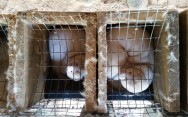Neglect and cruelty at Miami’s Seaquarium: Owners Forced to Vacate
The Miami-Dade commission has served eviction papers to the Dolphin Company, the owners of the Miami Seaquarium, after the company presided over severe neglect and poor conditions for animals in their care for many years. The Miami-Dade commission has ordered the Dolphin Company to vacate the premises by the 21st of April 2024. The commission’s letter cited violations of the lease agreement which included “not just a default, but a complete disregard for the safety of the animals housed on the premises.”
The history of the park is one of sadness, neglect, cruelty and enslavement for animals. The park’s history as an amenity for humans on the other hand, is one in which it enriched a private company and in the park’s earlier years was the third largest contributor to Miami-Dade County’s revenue through lease and tax payments.
The park is behind at least $180,000 in rent, which is one reason for the Miami-Dade commission’s decision. The decision was also motivated by the park’s numerous USDA violations and the loss of its Humane Society of America certification. Animal rights organizations have spoken out against the facility for years, in some cases managing to rescue animals, such as a pair of manatees, Romeo and Juliet. At least 120 dolphins and whales have died in captivity at the park. A dolphin named Sundance recently died shortly after a USDA inspection, where it was noted that the dolphin had “signs of gastric distress.” Federal inspections showed that the park’s infrastructure was deteriorating. A dolphin was found with a two-inch nail in its throat. Another dolphin was found with a broken metal bolt in its mouth.
One of the park’s major problems was that it couldn’t keep staff. Multiple staff resigned at the conditions of the park, and some alleged retaliation when they tried to speak up against the conditions. Due to money problems and difficulty retaining staff, the park didn’t have enough veterinarians to attend to the animals. The veterinary lab lacked basic tools and the animals were denied surgery, including a sea lion with eye pain, who stopped eating. One of the park’s animals, an Orca named Tokitae, gained recognition for all the wrong reasons, because the tank she was forced to live in was the nation’s smallest tank. Since coming to the world’s attention, Toki, also known as Lolita, has died.
Why did it take so long for the neglect to be put to an end? There is a bureaucratic process that has to happen to hold such facilities accountable. The park was known to be an unhealthy and cruel place for animals to live for decades. Attention wasn’t focused on the park soon enough because parks like these were for many years deemed to be acceptable entertainment and education for humans. The roles of animals at these parks, who are forced to perform for humans, and who are kept in restrictive conditions and separate from family members, were not questioned. It’s now time to question the rationale for keeping animals in these facilities. There may be some conservation reasons for keeping some species of animals captive, but even then, keeping animals in captivity, where they can be exploited, should be viewed with public skepticism and treated as a last resort.








Social Media